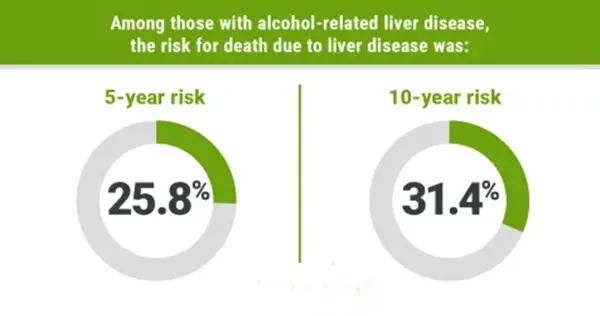New Delhi, Sep 21 (Healio) Liver disease was the primary cause of death in patients with alcohol-related liver disease several years after diagnosis, with the risk for mortality almost three times higher in those with decompensated cirrhosis, according to research.
“Patients with alcohol-related liver disease have a 1-year mortality risk of 25%, despite their young median age of 60 years,” Anna Emilie Kann, MD, of the gastroenterology and hepatology section at Zealand University Hospital in Denmark, and colleagues wrote in The Lancet Gastroenterology & Hepatology. “Knowledge of the causes of death in patients with alcohol-related liver disease is essential in the prevention of these premature deaths.”
They added, “Moreover, further knowledge of cause-specific cancer death in patients with alcohol-related liver disease is needed.”
Using data from nationwide health registries in Denmark, Kann and colleagues conducted a historical cohort study to investigate cause-specific mortality among 23,385 adults (median age, 58 years; 68% men) diagnosed with alcohol-related liver disease between January 2002 and December 2017, of whom 66% had cirrhosis.
Researchers monitored patients through December 2019 to determine an underlying cause of death.
During 111,532 person-years of follow-up, 67% of patients died. The overall mortality rate was 14.1 per 100 person-years and 18.6 per 100 person-years among those with decompensated and compensated cirrhosis. All-cause mortality risk for the entire cohort was 26.3% at 1 year (95% CI, 25.7-26.9) and 52.5% (95% CI, 51.8-53.1) at 5 years.
Of 11,904 deaths in the first 5 years after alcohol-related liver disease diagnosis, nearly half were caused by liver disease (n = 5,903). The 5-year and 10-year risks for death due to liver disease were 25.8% (95% CI, 25.3-26.4) and 31.4% (95% CI, 30.8-32.1), respectively.
In comparison, the 10-year risk for cancer-related death was 11% (95% CI, 10.6-11.4), while the risks for death due to alcohol use disorder and cardiovascular disease were even lower at 5.1% (95% CI, 4.8-5.4) and 4.5% (95% CI, 4.3-4.9), respectively.
Of cancer-related causes of death after 10 years, the most common was HCC (2.5%; 95% CI, 2.3-2.7) followed by lung (1.9%; 95% CI, 1.7-2.1) and oropharyngeal (1%; 95% CI, 0.9-1.1) cancers. The 10-year risk for HCC death was 3.2% (95% CI, 2.5-3.9) for decompensated cirrhosis and 0.7% (95% CI, 0.5-1) for steatosis or unspecified liver disease.
Researchers noted the 10-year risk for death due to liver disease, which was approximately 30%, “was similar in men and women, for different age groups and irrespective of diabetes,” but was three times higher among patients with decompensated cirrhosis (46.7%; 95% CI, 44.8-48.4) compared with those with steatosis or unspecified liver disease (16.2%; 95% CI, 15.3-17.2).
“Patients with alcohol-related liver disease constitute a unique patient group because they have chronic liver disease and the comorbidity of alcohol use disorder,” Kann and colleagues concluded. “We hope our findings will motivate further research into interventions to combat continued alcohol consumption in patients with liver disease.”





